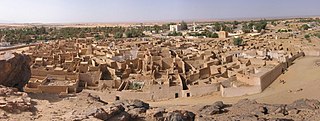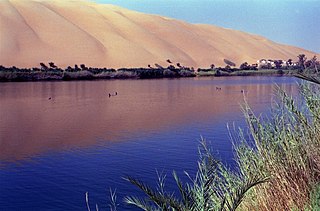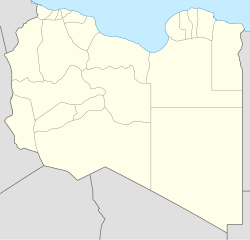
Libya is the fourth largest country in Africa and the sixteenth largest country in the world. It is on the Mediterranean with Egypt to the east, Tunisia to the northwest, Algeria to the west, Niger and Chad to the south, and Sudan to the southeast. Although the oil discoveries of the 1960s have brought immense wealth, at the time of its independence it was an extremely poor desert state whose only important physical asset appeared to be its strategic location at the midpoint of Africa's northern rim.

Tripoli is the capital and largest city of Libya, with a population of about 1.317 million people in 2021. It is located in the northwest of Libya on the edge of the desert, on a point of rocky land projecting into the Mediterranean Sea and forming a bay. It includes the port of Tripoli and the country's largest commercial and manufacturing center. It is also the site of the University of Tripoli.

Tobruk or Tobruck is a port city on Libya's eastern Mediterranean coast, near the border with Egypt. It is the capital of the Butnan District and has a population of 120,000.

Murzuq is a districts of Libya in the south of the country. Its capital is Murzuk. The city was occupied by the Ottoman Empire in 1578 and served as the capital of Fezzan off and on until the Ottomans ceded Libya to Italy in 1912. It was not occupied by the Italians until 1914.

Saif al-Islam Muammar al-Gaddafi is a Libyan political figure. He is the second son of the late Libyan leader Muammar Gaddafi and his second wife Safia Farkash. He was a part of his father's inner circle, performing public relations and diplomatic roles on his behalf. He publicly turned down his father's offer of the country's second highest post and held no official government position. According to United States Department of State officials in Tripoli, during his father's reign, he was the second most widely recognized person in Libya, being at times the de facto prime minister, and was mentioned as a possible successor, though he rejected this. An arrest warrant was issued for him on 27 June 2011 by the International Criminal Court (ICC) for charges of crimes against humanity against the Libyan people, for killing and persecuting civilians, under Articles 7(1)(a) and 7(1)(h) of the Rome statute. He denied the charges.

Ghat is the capital of the Ghat District in the Fezzan region of southwestern Libya, located just east of the Algerian border.

Sabha or Sebha is an oasis city in southwestern Libya, approximately 640 kilometres (400 mi) south of Tripoli. It was historically the capital of the Fezzan region and the Fezzan-Ghadames Military Territory and is the capital of the Sabha District. Sabha Air Base, south of the city, is a Libyan Air Force installation that is home to multiple MiG-25 aircraft.

Murzuk, Murzuq, Murzug or Merzug is an oasis town and the capital of the Murzuq District in the Fezzan region of southwest Libya. It lies on the northern edge of the Murzuq Desert, an extremely arid region of ergs or great sand dunes which is part of the greater Sahara Desert.

Ghadames or Ghadamis is an oasis town in the Nalut District of the Tripolitania region in northwestern Libya.
Kufra is a basin and oasis group in the Kufra District of southeastern Cyrenaica in Libya. At the end of the 19th century, Kufra became the centre and holy place of the Senussi order. It also played a minor role in the Western Desert Campaign of World War II.

Gaberoun is an oasis with a large lake in the Idehan Ubari desert region of the Libyan Sahara. Administratively, it is located Wadi al Hayaa District of the Fezzan region in southwestern Libya.

Hun or Houn is an oasis town in the northern Fezzan region of southwest Libya. The town is the capital of the Jufra District. The "International Autumn Tourism Festival" is an annual festival usually held at the end of September.

Ajdabiya is a town in and capital of the Al Wahat District in northeastern Libya. It is some 150 kilometres (93 mi) south of Benghazi. From 2001 to 2007 it was part of and capital of the Ajdabiya District. The town is divided into three Basic People's Congresses: North Ajdabiya, West Ajdabiya and East Ajdabiya.

Waddan is an oasis town of the Sahara Desert in the northeast Fezzan region of southwest Libya, in the Jufra District. It was an important town on the ancient trade routes across the Sahara.
Zintan is a city in northwestern Libya, situated roughly 136 kilometres (85 mi) southwest of Tripoli, in the area. The city and its surrounding area has a population of 16,024.

Moussa Ibrahim Gaddafi is a Libyan political figure who rose to international attention in 2011 as Muammar Gaddafi's Information Minister and official spokesman, serving in this role until the government was toppled the same year in the Libyan Civil War. Ibrahim held frequent press conferences in the course of the war, denouncing rebel forces and the NATO-led military intervention, often in defiant and impassioned tones. His status and whereabouts remained unknown following the Battle of Tripoli in which the Gaddafi government was overthrown, although there were several claims and subsequent refutations of his capture. Eventually, in late 2014, it was discovered he was in Egypt before he was deported and fled to Serbia. On 12 January 2015 Moussa Ibrahim spoke publicly by video link at a political event hosted at the Committee Rooms Houses of Parliament, Westminster, London from an undisclosed location, also the Director of Private Security Company.
The Fezzan campaign was a military campaign conducted by the National Liberation Army to take control of southwestern Libya during the Libyan Civil War. During April to June 2011, anti-Gaddafi forces gained control of most of the eastern part of the southern desert region during the Cyrenaican desert campaign. In July, Qatrun changed to anti-Gaddafi control on 17 July and back to pro-Gaddafi control on 23 July. In late August, anti- and pro-Gaddafi forces struggled for control of Sabha.

The Battle of Tripoli, sometimes referred to as the Fall of Tripoli, was a military confrontation in Tripoli, Libya, between loyalists of Muammar Gaddafi, the longtime leader of Libya, and the National Transitional Council, which was attempting to overthrow Gaddafi and take control of the capital. The battle began on 20 August 2011, six months after the First Libyan Civil War started, with an uprising within the city; rebel forces outside the city planned an offensive to link up with elements within Tripoli, and eventually take control of the nation's capital.

Gaddafi loyalism, in a wider political and social sense also known as the Green resistance, consists of sympathetic sentiment towards the overthrown government of Muammar Gaddafi, who was killed in October 2011, and his Third International Theory. Despite Muammar Gaddafi's death, his legacy and Jamahiriya ideology still maintains a popular appeal both inside and outside Libya into the present day. Regardless, the Western sentiment has largely been that this continued support may contribute to some of the ongoing violence in Libya.

The Ubari Desert, Idehan Ubari, Idehan Awbari or Ubari Erg is an erg in the hyper-arid Fezzan region of southwestern Libya with a surface of approximately 58,000 km2. The area of the Ubari desert has been traditionally inhabited by Tuareg people, a Berber ethnic and traditionally nomadic pastoralist group.


















